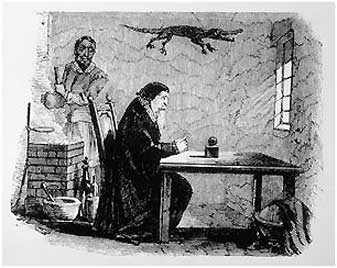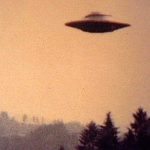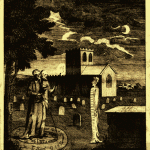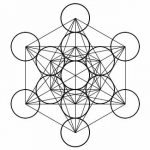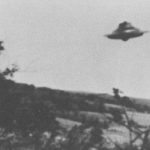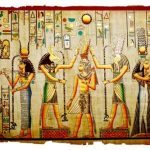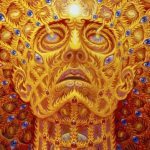During the spring of 1581, John Dee had a close encounter with an angel. He was praying in the chapel of his Mortlake home when a sharp rapping sound drew him to the curtained windows. Throwing aside the drapes, John Dee came face to face with a shining being floating a full 12 feet off the ground. The being gestured for Dee to open the window. When he did, the shining figure handed him a smoky quartz egg about the size of a baby’s head. Dee took the quartz egg, and the figure vanished.
It is easy, from a modern perspective, to dismiss this incident as a superstitious legend, but the crystal still exists, on display in the Manuscript Room of the British Museum. Dr. Dee kept careful records and made notes almost obsessively. We have notes on the construction of his other scrying glasses, as these types of crystals were known, but nothing, except the above incident, about the smoky quartz egg. Even Dee’s first biographer, Meric Causabon, who was anything but sympathetic, simply reports the origin of the crystal without comment.
However strange this encounter may be, it is the use Dee made of his angelic gift that is the crux of the story.
John Dee was born in 1527 and his formative years were colored by the religious turmoil brought on by the Reformation. Dee’s family, through which he would later claim distant kinship with Queen Elizabeth, arrived in London in the wake of Henry Tudor’s coronation as Henry VII. His father was a gentlemen’s gentleman for Henry VIII, and John Dee’s character was molded in a climate of religious protest and reaction. By the time he went up to Cambridge at fifteen, he was searching for a resolution to the problem of religious authority, seeking a type of spiritual science that could supply insight into the workings of nature by infusing the natural world with mystical meaning.
After studying at Cambridge and Louvain, Dee achieved the status of renaissance celebrity in 1550 with a lecture on mathematics and the spiritual aspect of number at the University of Paris. During the reign of Edward VI, Dee became involved in the political maneuverings around the throne and by the summer of 1555 found himself in prison on an unspecified ecclesiastical charge. Catholic Mary, “Bloody Mary,” had succeeded the young Edward and times were tough for Protestant mathematicians and magicians, especially for those known to have cast horoscopes of the Queen. Dee spent three months in prison. His cellmate went to the stake, as did over six hundred others, for witchcraft and heresy.
Dee survived his trial and lived to joke about it with his new patron, Queen Elizabeth I, who was also accused in the plot. Soon after her coronation, he was proclaimed the Royal Astrologer and given, specifically, freedom from ecclesiastical harassment. Dee settled in at his family home, Mortlake, which would eventually house the largest library of its time in all of Europe. Only the great national collections of the next century surpassed it. In the early 1580’s Dee listed over 4000 thousand volumes, 3000 printed books and over 1000 in manuscript. The libraries of Oxford and Cambridge together numbered less than a quarter of that total. Mortlake acted as the Elizabethan equivalent of a university research center, and it was said that the library contained the whole of renaissance thought.
At the end of 1562, Dee departed on an expedition to the continent proposed by Lord Burleigh, Queen Elizabeth’s chief minister, and Sir Francis Walsingham, the head of Elizabeth’s intelligence service. The exact reason for this intelligence gathering venture remains unknown, although Lord Burleigh thought the “Monas Hierogliphica,” which Dee published later during the trip, “of the utmost importance for the security of the realm.” In a letter to Sir William Cecil, written in February 1563 from Antwerp, Dee announced that his quest had been successful already. Apparently, he had made contact with a group or society that taught him more about recondite philosophy, Dee writes, than he had dared hope possible. In the letter, Dee summarized the important points of the “Radical Truths” he had discovered. Rather than wade through several pages of Elizabethan prose, we can paraphrase:
*All is unity, created and sustained by God through his Laws.
*These Laws are predicated upon Number.
*There is an art of combining Hebrew letters and equating them with Number so as to perceive profound truths concerning the nature of God and His dealings with Man.
*Man is of divine origin. Far from being created out of dust, as in Genesis, he is in essence a “star-daemon:” a spirit connected with the stars.
*As such, he has come from God, and must return to Him.
It is essential to regenerate the Divine essence within Man, and this can be done by the powers of the Divine intellect.
*God manifests by means of ten progressively more dense emanations; and man, by dedicating his mind to the study of Divine Wisdom, by refining his whole being, and by eventual communion with the angels themselves, may at last enter into the presence of God.
*An accurate understanding of the natural processes, visible and invisible, enables Man to manipulate these processes through the powers of his will, intellect and imagination.
*Whatever is in the Universe possesses order and agreement and is similar in form to everything else.
In addition to these truths, Dee was excited about a book, the “Steganographica” of Trithemius, the Abbot of Sponheim. He spent ten days copying a manuscript of this work and crowed to Sir William about its value. The “Steganographica” appears to be a textbook on codes and ciphers, all very valuable to spies and intelligence networks, but is really a hermetic text on angelic communication. Designed so that the codes and ciphers described in the first section of the book must be used to read the second section on angelic magick, Trithemius’ masterpiece works like our modern interactive games. The reader has absorbed the mind-set or world view of the book by the time the important information is reached.
This trip was the beginning of Dee’s quest for the direct experience of his “Radical Truths.” From Antwerp he departed on a year long tour of the great hermetic thinkers of his time. In the winter of 1564, he wrote The “Monas Hieroglyphica” in one long twelve day explosion of insight. In spite of its intentional obscurity, the “Monas Hieroglyphica” became the renaissance equivalent of a best seller and attracted comment from the best minds of the next century and a half.
At the center of the work is a talismanic diagram that resembles the astrological symbol for Mercury, but with some significant changes. From this symbol, Dee extrapolated a complex system of mystical geometry, which he thought embodied the underlying unity, or monas, of the universe. However, having no desire for a heresy charge, Dee left the application of this universal symbology rather vague.
His readers, who knew the code and could understand the meaning and implied practical applications, made Dee’s work into one of the cornerstones of Alchemy. They thought that Dee had discovered a universal symbol that, when engraved in the psyche, would allow man to experience the gnostic revelation. This revelation, in which all knowledge — gnosis — was received, then allowed one to operate as a lens or focus for spiritual activity. We can think of this idea as the basic definition of a shaman or a magician.
After 1564, Dee published only mathematical and scientific works. His edition of Euclid, with the “Mathematical Preface,” appeared in 1570, and in 1577 his “Perfect Arte of Navigation” was published. Virtually nothing else appeared in print in his lifetime. Apparently, during the 1570’s, his interest in the “Radical Truths” came to outweigh everything else. Dee had achieved earthly fame and had made significant contributions to the development of several hard sciences in his own time. Increasingly, it must have seemed that only non-local, non-physical intelligences could answer Dee’s ever more complex questions.
From 1563 on, Dee had the tools and the basic understanding to embark on an exploration of angelic communication, the idea that had led him to copy Trithemius with such excitement. His notes, however, record only a few attempts, done without much enthusiasm. That is, until the angel rapped on the window.
The logic of turning to supernatural forces for knowledge about the universe seems strange to our modern scientific sensibilities. This is a category of experience that “science” has labeled subjective and therefore suspect. To Dee’s contemporaries it seemed less unusual. The possibility of acquiring knowledge by revelation or inspiration was a vital component of the renaissance paradigm. In the “Mathematical Preface” to his edition of Euclid, Dee asserts that man “participates with Spirits, and Angels: and is made to the Image and Similitude of God.” He also notes that there are powerful precedents for angelic communication, the traditions of Enoch and Esdras, Abraham and Elijah and Moses, and “sundry others thy good angels were sent (to) by thy disposition, to Instruct them.”
John Dee’s encounter with the angel was the defining moment in his life. As if he had been waiting for just such a sign, some token of divine favor perhaps, Dee launched into a search for a way to use the quartz egg as a means of communication with the shining angelic beings. His first serious attempt, on December 22, 1581, involved a man by the curious name of Barnabus Saul, one of Dee’s servants, who acted as a medium or seer. Apparently, he was a better footman than a medium, for after a few sessions we hear no more about him.
By March 1582, however, Dee’s seer had located him.
***
“Mortlake: In the Name of Jesus Christ, Amen. In the year 1582, on the 10th day of March, before noon, Saturday.
“One Mr. Edward Talbot came to my house and he being willing and desirous to see or show some thing in spiritual practice. . .”
So begin Dee’s notes of his first scrying session with his new seer, Edward “Talbot” Kelly. At first, Dee was suspicious of the young man, and rightly so. He appeared unannounced, offering a fake name — he might have been a spy seeking information on Dee’s spirit conjurations — and even when identified proved to have an unsavory reputation. Dee soon resolved his doubts however; and, on an early spring morning roughly a year after Dee’s angelic visitation, they sat down to a trial run with the scrying stone. It is hard not to be impressed by the vivid quality of the quickly written notes of the proceedings. Kelly fell to his knees before Dee’s desk and began to pray over the stone; surprised, Dee took Kelly and the stone into his chapel, or oratory.
Within a quarter of an hour, Kelly began to see an angelic shape in the crystal. This being identified itself as the Archangel Uriel, accompanied by Raphael and Michael. Dee was hooked by this immediate success, and so began a long strange relationship between these two men and the angels. For the next seven years, they conducted almost daily sessions. Dee of course wrote everything down in his “Spiritual Diaries,” and reading them becomes after a while an exercise in applied surrealism. As an example of a dialogue with the deep unconscious Other, they are unparalleled.
At this first session, the Archangel Uriel revealed his sigil, a rather stylized energy signature, and gave preliminary instructions for a powerful talisman called the Sigil of Truth. Fashioned of wax, it was meant to be used in all future sessions as the base for the scrying crystal. This seal or sigil is at first glance similar to earlier ones by Aggripa and Reuchlin, but the version the spirits produced for Dee and Kelly is more detailed and aesthetically satisfying. Designed as an embedded heptagram/heptagon with a pentagram in the center, the Sigil of Truth theoretically acted as a template or pattern buffer for truthful communication.
The Sigil of Truth also functioned as a geometric foundation on which the rest of the angelic system grew. Around the outer edge of the Sigil is a series of letters and numbers. From these, the angels derived a series of great elemental names, which were said to describe the forces ruling each elemental tablet. The names of the angelic beings within the heptagon/heptagram were transmitted in the form of letters arranged in squares. These squares were then read in different directions to produce even more angelic names. This gives the impression of a vast fractal universe in which the nature of the intelligence consulted depends on the symmetry angle of your approach.
On March 26, Kelly was shown a great book with the leaves filled with squares. For the next 13 months, Dee and Kelly struggled to copy the contents of this angelic volume, despite interruptions and interference from the spirits. The records of these sessions are full of odd material, elemental distractions and strangely accurate prophesies. Some times the spirits wouldn’t appear at all. This behavior suggests that the spirits were of several types, with differing agendas, and that they had other things to do than wait for Dee and Kelly to show up for their lessons.
The vision of the book marked the first appearance of material concerned with the angelic language. Since our Mayan origin point for this evolutionary cycle, 3113 BC, there have been something like seven thousand natural languages recorded. Human ingenuity has created perhaps another thousand languages, mostly for religious and magickal uses. But we have no record of any language stranger than the one that emerged from these scrying sessions. Dee and Kelly’s Angelic or Enochian language is unique. Even now, it is impossible tell if it is a natural or invented language, or whether it is, indeed, the language of the shining angelic beings.
The alphabet appeared first; twenty-one special characters each with its own title. The titles are odd, with little relationship between title and the phonetic value of the character, and were dictated in three groups of seven totaling 64 characters in all, which suggests another magickal square arrangement. It also suggests the I Ching, the codons of DNA and the Tzolkin calendar of the ancient Mayans. As an added bit of strangeness, 21 is exactly the number of symbols needed to transcribe phonetic English without confusion.
These characters were then used to dictate the first texts in the angelic language. On Good Friday, March 29, 1582, the angels began with a slow deliberate method — the angel spelled each word, letter by letter, and then Dee wrote out the English and read it back — to fill in a large 49 x 49 square, where each square was a word and each line a text. After two lines of text, Dee expressed a desire for a simpler method. Annoyed at the request, the angel departed. By the following Tuesday, when the session reconvened, the angels were prepared with a completed square from which Kelly could read off the text. Kelly however had not memorized the letters given the previous week.
Annoyed again, the angel intervened.
A voyce — Read. E.K. — I cannot.
: You should haue lerned the characters perfectly and theyr names, that you mowght now haue redily named them to me as you shold see them.
A voyce — Say what thow thinkest. (Dee- he sayd so to E.K.)
E.K. My hed is on fire.
A voyce — What thow thinkest, euery word that speak.
E.K. I can read all, now, most perfectly, and in the Third row this I see to be red.
Palce duxma ge na dem oh elog. . .
(Sloane MS 3188, April 2, 1582)
What happened here? The angel said “What thou thinkest, every word, that speak,” and Kelly miraculously began to read. Perhaps he had notes hidden from Dee, but that “My head is on fire” comment suggests something very strange happened that afternoon. Did the angels, those non-earthly, non-local intelligences, force Kelly’s consciousness into resonance with a language pattern coded into our very DNA?
The answer seems to be yes. The texts which Kelly generated from the tables shown to him by the angels resemble the vast literary mandalas of Tibet, and like them are full of phonetic patterning, repetition, rhyme and alliteration. This type of verbal patterning is not found in normal speech, but is characteristic of poetry and magickal charms as well as “speaking in tongues,” or glossolalia, that is language produced under trance conditions.
There is no question that Kelly was in some kind of trance during these sessions. Dee notes many occasions indicative of a deep trance state on Kelly’s part. However, this does not mean that the “language” produced in these sessions was meaningless gibberish. The phonetic patterning is also similar to verb tense and other grammatical drills. Perhaps Kelly was constructing, in a trance state, the linguistic links his unconscious needed in order to receive a more complete form of the angelic language, one that developed from these original text filled squares.
The squares of the Liber Logaeth, or the “Book of the Speech from God” as Kelly called the great book of his vision, did indeed form the basis of a new series of 49 invocations dictated in the spring of 1584, while Dee and Kelly were in Cracow, Poland. Unfortunately, the details of how this version of the Enochian language developed from the squares is very unclear. All we can be sure of is that it was generated somehow out of the previous tables and squares, and this time a translation was provided right from the start.
With these translations, we begin to find a real language emerging. The grammar and syntax are similar to English, perhaps because of Kelly’s unconscious linguistic processes, but vocabulary elements, roots and prefixes and case endings, are not directly derivable from English, Greek, Latin or Hebrew. Some words suggest Sanskrit and ancient Egyptian roots, languages completely unknown to either Dee or Kelly.
In fact, in the earliest sessions on the Sigil of Truth, we find that the name of the elemental king of fire, generated by following a symbolic pattern around the letters and numbers on the rim of the seal, is a perfectly good phonetic rendering of an ancient Egyptian phrase. Following the pattern, which was dictated several years after the Sigil itself, we produce the name Oheooaaatan, pronounced Uh-heh uh-ah-ah ah-ton.
In hieroglyphic Egyptian that becomes uha uhah aton, the very phrase in one of Ra-Harakte’s titles, translated as “the penetrating and destructive power of the sun’s disk,” from which Amenhotep III took the word Aton and turned it into a new definition of divinity. Before we dismiss this as a coincidence, we should note that the elemental king of earth, derived by the same method, renders as Tha-ha-oo-teh, or simply Tehuti, or Thoth to the Greeks.
This is simply astonishing. Phonetic Egyptian did not even exist as a concept. Athanius Kircher declared in the 17th century that all hieroglyphs were symbolic rather than phonetic, and no one thought otherwise until Champollion in the early 19th century. Where did Dee get these Egyptian words and phrases?
We are left with a deep mystery.
The sessions continued until 1589, when Dee returned to England. They produced a vast quantity of material, including the Elemental Tablets ruled by the Great Kings named on the rim of the Sigil of Truth. Kelly remained in Europe and died in 1595 while trying to make his escape after a failed alchemical scam. Dee survived until 1608.
Hard as they worked to produce this mountain of magickal material, Dee and Kelly seem never to have done anything with it. Kelly used some formulas given to him by the spirits in his alchemical “research,” but beyond that no further work was undertaken until Elias Ashmole in the next century. Perhaps it was enough just to have received the information.
What are we to make of all this? From the evidence of Egypt, we have speculated that our use of language and our ability to visualize complex forms, such as letters and glyphs, allows our thoughts to attain a degree of coherence. Dee’s “Radical Truths” demonstrates that these precepts survived the millennia, perhaps as the secret intellectual property of some descendent of the Ra Cult. Dee revealed much of the secret in his “Monas Hieroglyphica,” as if to say to the world, or other worlds, “Here it is, we still remember.”
The angels came looking for Dr. Dee, much as Michael Rene, the space visitor, sought out Sam Jaffe, the brilliant physicist, in “The Day the Earth Stood Still.” What they communicated was a geometrical, symmetry based, DNA coded language pattern capable of producing a rapid expansion of consciousness and an increase in symbol coherent cognition. This unique language form also appears to have Sanskrit and ancient Egyptian roots. Dr. Dee understood the information’s importance, but the rest of the world, in the late 16th century, was very much not interested.
In many ways, Dee and Kelly’s experience is similar to nineteenth century spiritualism and the modern UFO contactee phenomenon. Even the types of prophecies, Mary Queen of Scots’ execution and the Spanish Armada, are familiar to us from their modern versions. To most historians, Dee’s work is the dividing line between medieval superstition and modern science. Dee is indeed a turning point, but, rather, it is one between intervention and non-intervention. In the four hundred years between Dee’s time and ours, one Mayan baktun, the secret has never completely disappeared. Faced with the approaching 5200 year deadline of the Mayan Calendar, the level of intervention has reached a frenzied pace in the last hundred and fifty years. Had Kelly and Dee been born in Victorian England instead of Elizabethan, they might have achieved fortune and fame, or at least notoriety. With the spirits’ help, of course.
More Articles from Sangraal.com:
Submit your review | |

